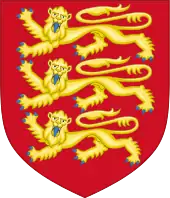Richard Middleton (Lord Chancellor)
Richard Middleton (sometimes Richard of Middleton[1] or Richard de Middleton;[2] died 7 August 1272) was an English ecclesiastic and Lord Chancellor of England.
Richard Middleton | |
|---|---|
| Archdeacon of Northumberland | |
| Province | Durham |
| Appointed | before 23 September 1271 |
| Term ended | before 7 August 1272 |
| Predecessor | Roger de Herteburn |
| Successor | Thomas de Birland |
| Other posts | Lord Chancellor |
| Personal details | |
| Died | 7 August 1272 |
| Lord Chancellor | |
| In office 29 July 1269 – before 7 August 1272 | |
| Monarch | Henry III, Edward I |
| Preceded by | John Chishull |
| Succeeded by | Walter de Merton |
Middleton was appointed Lord Chancellor[2] on 29 July 1269. He was out of office before his death, but his successor Walter de Merton is first mentioned in the office on 29 November 1272.[3]
On 5 January 1270 Middleton was given the living of the church at Hemingbrough in the East Riding of Yorkshire by the cathedral chapter of Durham Cathedral. He was also Archdeacon of Northumberland, occurring in that office on 23 September 1271 and in 1272.[2]
Middleton died on 7 August 1272.[2]
Citations
- Staff "Lord chancellors of England and Great Britain" Oxford Dictionary of National Biography
- Greenway Fasti Ecclesiae Anglicanae 1066–1300: Volume 2, Monastic Cathedrals (Northern and Southern Provinces): Durham: Archdeacons: Northumberland
- Fryde, et al. Handbook of British Chronology p. 85
References
- Fryde, E. B.; Greenway, D. E.; Porter, S.; Roy, I. (1996). Handbook of British Chronology (Third revised ed.). Cambridge, UK: Cambridge University Press. ISBN 0-521-56350-X.
- Greenway, Diana E. (1971). Fasti Ecclesiae Anglicanae 1066–1300: Volume 2, Monastic Cathedrals (Northern and Southern Provinces): Durham: Archdeacons: Northumberland. Institute of Historical Research. Retrieved 11 January 2017.
- Staff. "Lord chancellors of England and Great Britain (1060s–2012)" ((subscription or UK public library membership required)). Oxford Dictionary of National Biography. Oxford University Press. Retrieved 11 January 2017.
This article is issued from Wikipedia. The text is licensed under Creative Commons - Attribution - Sharealike. Additional terms may apply for the media files.
